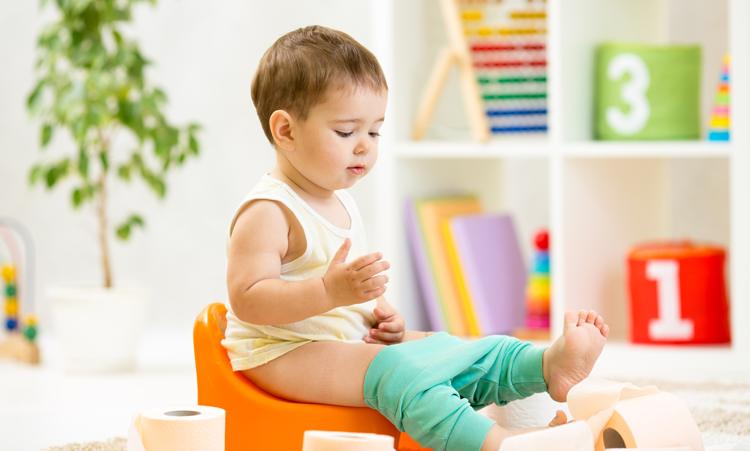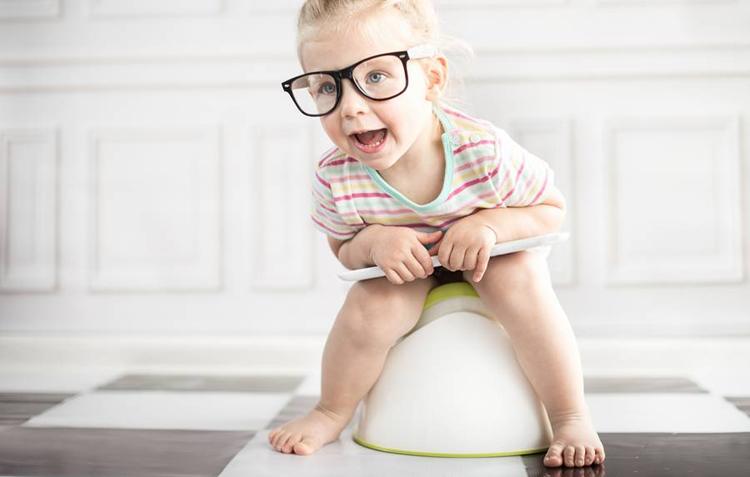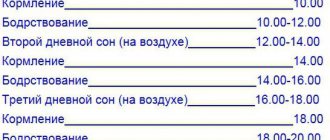Diapers are a great invention, thanks to which many mothers do not have to deal with endless washing and ironing most of the time after childbirth. Sooner or later, parents have to introduce their baby to the potty. This happens differently in every family and at different ages. Someone already at one and a half years old runs to him, pulling off his pants as they go, while others go through a tough school of growing up in kindergarten, learning the rules of self-care with the help of teachers and nannies. How to potty train a child, and what to do if he refuses to use it?
When is the best time to introduce your child to the potty?
Children begin to learn new skills easily when they are physically and mentally ready. No sane mother would force a child to crawl or stand on his legs if he is not yet mature for this. Experts also recommend that parents take their time when it comes to the toilet, since it is much easier to potty train a child when he is already 2 years old. If a baby under this age is forcefully placed on an incomprehensible object, making sounds like “piss-piss,” he will not understand anything and will resist. Sometimes children are so intimidated that they start crying at the very sight of a potty.
When to start training? If the child does not need to go to kindergarten soon, the mother can track his behavior. The baby will always give a sign that he wants to go to the toilet. Everyone has their own. One begins to shudder or freeze, the other will strain or grunt. You need to seize such a moment and quickly put him on the potty. If you are on time several times, the baby will begin to understand the true purpose of the potty.
At what age should young mothers be interested in potty training a child? 1.5-2 years is considered optimal.
Before this, children find it difficult to control their needs. The baby does not notice that the bladder and intestines are full. If a neighbor brags that her one-year-old son can already poop in a potty, this does not mean that the problem has been solved on a conscious level. They just plant him there with enviable regularity. The reflex is triggered. If you managed to plant it on time, everything works out, if not, he will shit his pants.
When the child is already able to:
- squat down and get up without anyone's help;
- collect various objects from the floor, put them in their places;
- sit on the potty on your own (even without taking off your panties) or place toys on it;
- understand well what is being said to him, accept praise from parents, requests and encouragement;
- say a few words, communicate your desires;
- stay dry after waking up during the day, do not pee, staying awake for 1.5-2 hours;
- feel that wet and dirty panties are uncomfortable
Mom can safely begin toilet or potty training.
Important! Each child develops individually.
The age at which they switch to the potty after diapers also differs. If a baby pees on the potty at one year old, this is not related to his meaningful habits. He must clearly understand what he is doing, and not follow reflexes.
Which potty will help potty train your child?
In order for the training process to go quickly and effectively, it is important not only to know how and when to potty train a child, but also to choose the right “unit” itself.
If you want your child to calmly sit on the potty according to his needs, you need it to be comfortable. Therefore, recently preference has been given to potty chairs, which in their structure meet the requirements of the baby’s anatomical structure. The material from which the pot is made must be warm, since contact with a cold surface can only cause negative sensations in the child, especially if he is planted immediately as soon as he wakes up.
In addition, the potty must be stable, since often, especially at night, children stand on the potty or are put out by their mothers almost in their sleep, when the child has poor control of his movements. Therefore, there is a high probability that the child will simply fall off it, and after the first such fall, he will avoid the potty for a long time.
Also, in pursuit of buying their child the best, many parents spend money on the most expensive and beautiful models that have music and game panels so that the baby does not get bored in the process. From the point of view of teaching a baby to urinate on the potty, these are the most inappropriate models. Since these additions, designed to attract the attention of the baby, in fact, perform the opposite task of the original one - they distract him from the very meaning of sitting on the potty. Therefore, the model of the pot should be the simplest without frills. It’s good if it’s light, because when the baby grows up a little, he, looking at his mother, will also want to clean it, and if the potty is heavy, the baby won’t have a chance to even try to do this. As a result, the little one may become upset and even refuse to use it out of resentment.
Advice! When your child goes to the potty, you should clap your hands, smile widely and praise your child. This method works better than ringing a tune because children are always eager to please their parents. Your approval will also increase your child’s self-confidence and raise his self-esteem. Praise, smiles, and handclaps should be repeated every time your child successfully uses the potty. If your child has "accidents", just tell him it's no big deal and he'll do it in the potty next time. Never scold your child for not going to the potty.
Which pot is better to buy
Children's goods stores offer a wide range of potties for boys and girls of any age. For girls they are made in a round shape, for boys they are oval with a small convexity in front, which corresponds to the anatomical structure of the body. You can choose any model - from a classic one to a pot in the shape of animals or cars. Consultants will tell young parents about the advantages and disadvantages of a particular product.
There are several points to consider that even an experienced seller may not be aware of:
- Warm material. The product should not be cold. It is unlikely that a baby, accustomed to warm diapers, soft diapers and tender mother’s hands, will like to touch his butt to iron or ceramics. It is advisable to choose plastic models. They are bright, attractive and comfortable, and most importantly, warm. They are easy to wash and disinfect.
- Convenience. In such a delicate issue, comfort and the presence of a backrest occupy an equally important place. You can choose an option for your little one that matches its anatomical characteristics. The main thing is that the hole is wide enough and does not dig into the baby’s body.
- Sustainability. An unstable toilet item can easily topple along with the child if moved awkwardly. This is fraught with a categorical refusal to sit on it next time.
- Mobility. Models with a removable cover can be taken with you on a trip.
- Efficiency. Pots with light or musical effects disturb children , distracting them from the main process. They are often perceived as toys rather than necessities.
- Quality. A good pot should be smooth, solid and solid. Cracks or sharp protrusions are not acceptable. We must not forget that the contents will need to be regularly poured into the toilet, so a strong, comfortable handle is an important element of the product.
If the pot consists of several parts, you should make sure that they are easily removable and accessible for washing. Otherwise, dirt will accumulate in the corners, and the necessary item will turn into a breeding ground for germs.

How to choose the right pot
A wide variety of potties in children's stores can confuse not only the baby, but also the adult. Each has its own positive sides and disadvantages, which can play a negative role.
Classic potty
For girls, they usually take a round shape, since in this case it is more convenient for her to move her legs. For boys, choose a slightly elongated oval shape. This way, his legs opposite him will be spread apart, and the genital organ will not be pinched by his thighs. This model is usually used in kindergartens. If you are going to send your baby to a nursery, this option is optimal.
Potty chair
A unique variation of the classic pot. Its base is a chair with a hole in the middle where the container is inserted. Maybe with a lid, like an imitation toilet.
Musical
Appeared relatively recently. It responds with a melody when liquid enters it. This makes the baby happy. However, this choice is not the best, since a conditioned reflex is developed to the underlying music. Therefore, hearing the same melody on the street, he may wet his panties.
Potty toy
To attract attention and interest, many parents choose a potty in the form of animals or cars. There are many varieties of them, some with additional functions such as sound or backlighting. But this type also has a significant drawback. By being distracted and staying too long on it, the baby worsens his health. Sitting in this position for a long time causes blood stagnation in the pelvic organs and can provoke inflammation.
Transformable pot
This type is very convenient, since at first it can be used as a regular potty, and after disassembling it, you get a stand for the toilet in the form of a ladder and a small “seat” on it. It is small in size and compact.
This is interesting: Complexes and exercise programs for losing weight for girls at home
Travel potty
This sample is good because you can take it with you on short trips and walks, including to the clinic. When folded, it looks like a regular flat seat. If necessary, the legs extend below, a disposable bag is attached, which is subsequently rolled up and thrown away. To avoid any incidents, before using it in public places, practice at home a couple of times so that your child gets used to it.
Although the choice is large, you should start with the simplest models, taking into account the anatomical features of a boy or girl.
It is preferable to buy a pot made of plastic. Wooden and metal ones are very rare, but they are inconvenient to use for several reasons. Wood tends to collect dirt and microbes in microcracks. The metal is too cold, which can cause colds in the genitals.
Video story
Training methods
Parents need to be extremely patient, since it will not be possible to potty train a one-year-old child in one day. You can make the process easier by following some recommendations:
- You need to introduce your baby to a new subject slowly, through play. It’s better to explain that this is a very good thing, and if you use it, your panties won’t be wet, and there will be much fewer puddles on the sofa or floor. A good example can be shown with toys by first placing, for example, a favorite bear on a potty, and then a hare;
- The child needs to be told that walking in wet clothes is unpleasant. The butt will begin to turn red and hurt. To avoid this, you need to go to the potty. It is advisable to place a toilet item in the children's room and squeeze the baby on it after waking up, walking and eating;
- encouragement is needed. If everything worked out, the child must be praised. Then next time the little one will definitely want to repeat his little success. If an “accident” occurs, there is no need to get upset and scold the baby. It is enough to gently remind him of the existence of a pot in the house, which will not allow his pants to get wet again;
- the pot should be in a visible and familiar place. If the child sits on it himself and is able to cope with his own affairs, the joy will be great, and the mother’s reaction will make him doubly happy;
- there is no need to pay excessive attention to the usual process, covering the baby with books and toys, arranging a puppet show. The act of defecation should not be associated with games .
When placing a child on the potty, you cannot hold him against his will until he pees. This will cause resistance, and when the baby is released, he will defecate somewhere else, but not on the treacherous potty. Then it’s better to forget about this subject for a while and try to lure the child in another way. The boy, like an adult, can be asked to pee while standing. For a girl, let a stream flow in the basin. If this helps, you can safely return to the potty, but not so forcefully.
Each person is individual. This must be taken into account when raising children. You can’t compare your baby to your neighbor’s kids the same age who have already learned the tricks of the toilet.
You can get a successful result by taking into account a few tips:
- You can quickly potty train a child when he is ready psychologically and physically. Parents who are constantly with him can determine this;
- It is necessary to sit the toddler on the potty after each awakening. If he does not wet himself in bed, then there is a chance that he successfully goes to the potty;
- if the baby is sick (teething, stomach pain, fever) there is no need to start training;
- do not scold the baby if he forgot about the potty and wet his pants;
- It is best to start training in the summer, when it is possible to walk naked for a long time or wear a minimum of clothing;
- the child’s attention should be fixed not only on the process of emptying, but also on removing clothes, pouring the contents into the toilet, returning the potty to its place;
- When urinating, do not use the sounds of flowing water. This may have a negative impact on the psyche in the future.
How to potty train in 7 days
Some mothers, wanting to reduce the number of diapers they use and reduce the number of washes, try to quickly train their child to go to the potty. How to properly potty train your child? There is a special method that allows the baby to get used to it in 7 days. It was developed by the famous midwife and author of many child care manuals, Gina Ford. The technique was approved by many women whose children already knew how to take off their pants and understand what they were being told.
- First day
On the morning of the first day, they remove the baby’s diaper and, offering to go to the toilet, lead him to the potty. The procedure, if the first attempt was unsuccessful, is repeated every 15 minutes until it ends in success. It is advisable to ensure that the child sits on the potty for about 10 minutes, this will be enough for him to have a bowel movement. You can sit next to him and entertain the baby so that he doesn’t jump out of his seat. If you fail to catch the moment, the child begins to resist, it is better not to insist. Patience is required here.
- Next 2 days
On the second and third days they follow the same principle. You need to watch the child, not letting him forget and relieve himself in his pants. If the seven-day method is chosen, diapers are not worn even for a walk. Before going out, the baby is asked to sit on the potty. And while walking, they ask if he wants to write in order to avoid an unpleasant surprise.
- Remaining 4 days
Already from the fourth day, parents and the child know approximately when to visit the “toilet friend”. If the child is interested in the game, he needs to be reminded of this and be sure to praise him if he is successful. Mom’s joy will be the impetus for the child’s final mastery of toilet skills.
How to potty train in 3 days
If you don’t push the baby, the process will drag on for a long time. You can potty train your child in 3 days using another proven method. But this does not mean that the baby will never misfire once he gets used to it. Such techniques convey to the child the importance of going to the potty and form the basis of toilet wisdom. For everything to be successful, you need to find out whether he is ready for this.
When assessing the feasibility of a quick training method, you need to focus on the following factors:
- such techniques are used for children under 2 years of age;
- the baby is able not to pee for 1-2 hours;
- The baby poops at approximately the same time.
These criteria indicate the baby’s readiness. But before you start training, you should prepare in advance. They begin to prepare 2-3 weeks before the transition to the planned actions:
- the child is shown a toilet friend, and every day they are told what it is for;
- they say that all children go to the potty, and then, like adults, to the toilet - and this is correct;
- A few days before training, the baby is informed that he will not wear diapers, because he is already big. Instead, he will have panties and in order not to spoil them or get them wet, he needs to pee in the potty. In order to arouse the baby's interest, they buy him a pair of panties with beautiful images.

Once the soil is ready, you can begin the process:
- On the first day in the morning, the diaper is not put on, replacing it with the selected panties. A quick training method involves the little one learning to pee on the potty while awake. Nighttime weaning from diapers will take longer. When the child begins to fully control his physical needs and elimination processes.
- If the temperature in the room allows, it is better to leave the baby without underwear for the whole day. If not, wear comfortable pants with a loose elastic band. Even after training, some kids may sit on the potty in their underwear, forgetting to take it off. Adults should carefully monitor him and at the first sign, put him on the potty. The child must understand the close connection between the actions performed and the potty. If the parents do not have time to catch him before the need is corrected, the connection will not be recorded in the mind.
- Each successful entry into the potty should be marked with joyful emotions and praise. It is better not to focus attention on failures, otherwise negative feelings will be associated with the toilet and training will be delayed. Before going to bed (day or evening), the baby must be offered to sit on the potty.
On the second and third days they do the same. You can go for a walk outside, but leave after the child goes to the toilet. Before going to bed or going for a walk, the baby is scheduled to sit on the potty, not forgetting to praise him after he has completed his business. After such active actions, the child will clearly form the concept of a potty in three days. He will calmly accept the “toilet theme”, and even ask or sit on it on his own. Over time, you will be able to ditch the nighttime diaper.
Retraining
Some parents are faced with the fact that their child, who regularly went to the potty, suddenly began to skip visits and again wet and dirty the laundry. This can happen at 1.5 or 4 years.
The reasons for this behavior are different:
- Stress associated with moving, the birth of a second child, long-distance travel. Children are very conservative and prone to anxiety. Even the simplest changes in life can cause a child to stop doing things that they used to do with joy. This also applies to the pot.
- At 3 years old, children experience an age crisis. The child tries to do everything the other way around. This time passes and everything falls into place. Parents need to experience these moments and not worry too much.
- Scandals between parents in the presence of a child can negatively affect his psyche, social adaptation and behavior.
- During illness, children often do not ask to go to the potty.
The reason for the aversion to toiletries must be identified and eliminated as quickly as possible.
Doctor Komarovsky's technique
The famous doctor Oleg Evgenievich Komarovsky advises starting training no earlier than 2-2.5 years, when the child is more or less ready for this, both psychologically and physiologically.
First of all, you need to introduce your baby to the potty. Explain why it is needed. Plant immediately after sleep, after eating, before and after a walk. And simply, when we realized it was time. In these cases, the success of the case is most likely. And then you should praise. But if there is a mistake, you need to remain silent.
At the age of 2 years, a child can take off and put on panties and tights. Therefore, the emphasis is not on the potty itself, but on a consistent process: first, he takes the potty, takes off his tights and panties, sits down, does his business, gets up, straightens himself and tells his parents what he did. This can be turned into an interesting game that the child will like and will continue to do of his own free will.
A visit to the toilet should gradually fit into the daily routine. However, complete abandonment of diapers is not recommended. It can be used for night and daytime sleep, walks in cold weather and long trips. But if the child wakes up dry, you urgently need to put him on the potty and praise him for such an “act.”
This is interesting: The benefits of beef fat for humans
Some babies immediately prefer the toilet. But this aspect is not so important. In this case, it is more important to choose a seat for a small butt and a stand so that it is easier for the baby to climb up there. This is especially a positive option for boys, as it is more convenient to write there. In this case, the example of dad helps a lot, showing how “real men” do it.
Refusal of diapers
New parents are constantly concerned about the question of how long it takes to potty train a child in order to give up expensive diapers? It is much easier not to use them during the day than at night. When the baby is awake, it is easy to catch him and sit him on the potty. When the skill of regularly visiting the toilet or potty is clearly developed, the night diaper will remain almost dry. Then you can be away from him without fear.
To be on the safe side, you should not rush to remove the oilcloth or waterproof diaper from the crib. The baby needs to be woken up twice a night and, sleepy, seated on the potty. Gradually, awakenings are reduced to once. The small organism will become accustomed to this ritual and will begin to control the process of urination during sleep. The child will wake up on his own, feeling the need. The potty should be placed near the bed and the night light should be left on.
Additionally : 3 ways to wean your child off diapers - only actual tips and tricks
Facts in your baby's behavior that help you understand that he is ready to use the potty
In connection with the development of medicine and the popularization of child psychology, pediatricians have formed the opinion that there is no specific age when it is time to potty train a child. The overwhelming majority of children, already at the age of one and a half years, can restrain the urge for a short time and run to the potty. But, nevertheless, different children develop differently, for some this moment comes earlier, while others have to wait.
It's time to potty train your child if:
- he repeats after you everything you do;
- he knows where something is and returns it to its place;
- he uses the word “no” more and more often, thereby showing that he can already do a lot on his own;
- when walking, he does not use the help of adults, sits and bends without losing his balance;
- he understands that he wants to relieve himself and can tell adults about it;
- he can take off and put on his pants independently;
- he can sleep all night without waking up;
- the break between urination is more than two hours;
- wet or dirty pants make him uncomfortable and he asks to change them;
- he understands what you say to him and can use gestures or his first words to explain what he needs.
If most of the points characterize your child’s behavior, then you can safely purchase a potty.
Why might a child be afraid of the potty?
It is difficult to potty train a child when he reacts poorly to it. This can happen for several reasons:
- When parents scold and even spank him for dirty or wet pants. Negative emotions accumulate, preventing the baby from calmly accepting the potty.
- When meeting a toilet friend turned out to be unsuccessful. Sometimes the potty seems too cold, unpleasant, and ugly for children. The pot needs to be hidden for a while, and then the introduction should be repeated. It’s better to buy a toilet friend in advance so that the baby can get used to it, know what it feels like and not perceive it as a scary object that needs to be sat on for some reason.
- Perhaps, when the child was sitting on the potty, he was frightened by extraneous sounds, or he fell from it and hurt himself painfully.
- In kindergarten, a “wet or dirty” problem can happen to any child. Unscrupulous teachers react to this violently, scolding the child in front of other children. When sending your child to a group, you need to ask what kind of toilet there is, whether there are pots, toilet paper, and whether the child can have privacy when the need arises. The absence of these conditions causes a delay in defecation before coming home, which causes constipation.
- The reason, which follows from the previous one, is physiological constipation. It can cause fear of the potty. The process of defecation in the baby begins to be associated with torture and pain. It is difficult to convince the baby that the pot is not to blame.
- Children's fears and fantasies do not bypass the potty (toilet). The child may be afraid that someone living in the toilet will grab his butt or bite him.
A mature child needs to create comfortable conditions for privacy so that he can relax and calmly go to the toilet. You can’t force a baby on the potty or force him to sit down if he resists. Such mistakes often discourage children from using the potty.
Where do you start potty training your child?
- Buy a potty that will be enjoyable and interesting for your child. Check its stability before purchasing, since it is unlikely that the child will want to “make friends” with it again after falling from it once. Do not forbid your baby to “communicate” with the potty, explore it and play with it. Explain to your child that the potty belongs ONLY to HIM.
- Don't hide the potty, let it be in sight of your son or daughter. It is advisable to leave it where the baby spends most of his time.
- If your baby doesn’t feel confident with a new object in the house, then leave the potty in a visible place until he gets used to its presence.
- Start potty training your child without removing his diaper or pants. As soon as the child gets used to this ritual, it will be possible to sit without panties. Never hold your baby on the potty without his consent!
- When the baby no longer tries to immediately get up from the potty and can sit on it longer, start putting him down after he has done his “business” in the diaper. At the same time, after changing the diaper to a clean one, do not forget to put the dirty one in the potty.
- Try to put your child on the potty at least seven times a day: after a night's sleep, after each meal, before a nap, before and after a walk, and before bed at night. If you managed to get your child to pee or poop in the potty, be sure to praise him and show him indescribable delight!
- Try letting your baby walk around the house without a diaper. Don't forget to praise if your baby expresses a desire to sit on the potty.
- Don't even think about putting your child on the potty at night until he has mastered using it during the day.
Reviews from moms
Review by Gulnara. We were potty trained in the summer at my grandmother's, when our son was 2 years 5 months old. We had been familiar with the potty for a long time and were not afraid of anything. They planted them after sleep and after eating. Within a week, he began to ask himself, although it happened that he still peed. It was easy to give up night diapers too. We don’t let him drink a lot in the evening, and at night I wake him up twice – at 2 o’clock and at 5. He calmly gets up, sits on the potty, and falls asleep again.
Review by Julia. I started teaching my daughter when she was 1.5 years old. I managed to get her to sit on the potty so she could pee. But she categorically refused to poop in it, became capricious and cried. I sat next to her and read books to her, and all our toys sat on him, but to no avail. I had to put a pot on my lap and plant her on top. We suffered until we went to kindergarten. There, looking at other children, he got used to it in a week.
Review by Galina. I don’t want to brag, but we only used diapers every day for the first month. At 3.5 months they were already wearing it only at night. During the day he was put on the potty until he went to the toilet. At six months he began to beg, grunt and get nervous until we put him over the potty. Now we have been sleeping peacefully at night for 9 months from 2 to 6 in the morning, then we wake up, pee, and go to bed again. The main thing in this matter is that the parents, and not the child, are in the mood for the potty.










